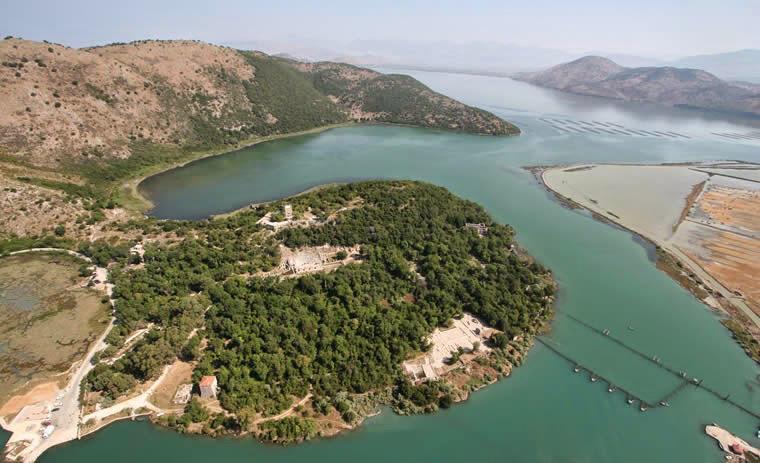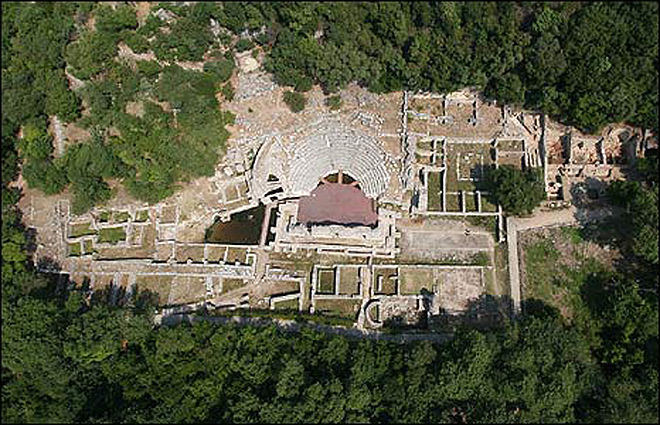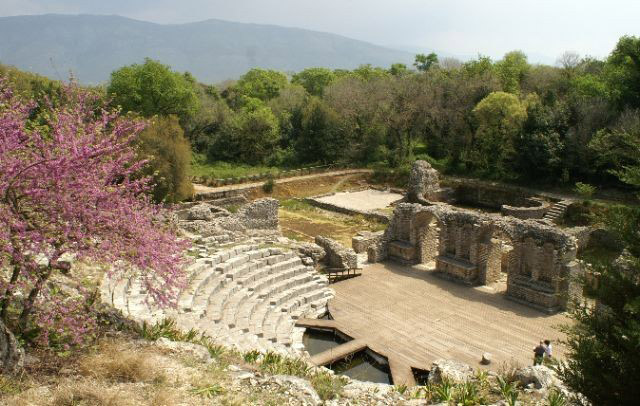Butrint - World cultural heritage in Albania
Unesco's Scientific, Educational and Cultural Organization recognized Albania's Butrint as a World Cultural Heritage in 1992.

Butrint is an ancient Greek city and is also an ancient relic in Sanrande of Albania, close to the Greek border. Butrint is located on a hill overlooking the canal of Vivari. During the Roman empire, Butrint was originally a land with a large population. According to the history of ancient Rome, the founder of Butrint was the prophet Helenus . The prophet Helenus is the son of King Priam of Troy.
According to archaeological evidence, this is the place of prehistoric people from about the middle of the 10th century to the 8th century BC. Butrint is in an important strategic position on the strait of Corfu. In the 4th century BC, Butrint residents built a temple to worship Lord Asclepius and an open square to meet.

Image Butrint viewed from above.
The year 228 BC, Butrint along with the island of Corfu became the protectorate of the Romans. The Roman Republic gradually dominated the Butrint region since 167 BC. By the time of the great Emperor Caesar , this land was often awarded by the Emperor to reward the generals with meritorious deeds. However, the lord of the land of Butrint at the time, Titus Pomponies Alticus , mobilized the Senate Institute to minimize this land, so in Butrint there were only very few generals who could live and build the mansion.

By about 30 BC, the period of Emperor Augustus. After the battle of Actium, the Butrint region became the main residence of veterans and soldiers of the Royal Corps. These new residents have expanded the city, built more houses, public buildings such as: 1 canal, 1 Roman public bath house, 1 open-air market area and 1 well .



In the 3rd century AD, Butrint suffered a major earthquake . The earthquake destroyed almost the entire city including houses and public buildings. Despite such destruction, the city survived and became a major port of the ancient Epirus region.

By the 6th century, Butrint began to have dioceses of Christianity . Also around this time, a church and a baptism house were built here. By the 7th century, the city was reduced to a small fortress after the Roman forces completely collapsed. Bultrint was controlled by the Bulgarian empire for a short time (632 - 1018). During the Bulgarian empire control Butrint, there was a lot of wine and oil from the Mediterranean land imported. By the end of the 9th century, the Byzantine Empire recaptured Butrint from the Bulgarian hands. In a short period of time, the land of Butrint was constantly fighting against Norman attacks. Until 1204, after the 4th crusade, Byzantine Empire broke up. The city changed hands many times in later years. In 1267, Charles I took control of Bultrint and the island of Corfr. In 1386 Venezia Republic purchased this land with the island of Corfu from Angevin people. However, merchants of that period only focused on Corfu but did not care about Butrint. So Butrint once again fell into a recession, forgotten. In 1797, Butrint fell into French hands, when Venice ceded the land to Napoleon under the Treaty of Campo Formio. In 1799, a local general took over the land until Albania was completely independent of 1912. However, this period in Butrint few people lived and lived.

Until 1928, new archaeological excavations were conducted here. The first excavation was sent by an Italian government to an expedition with the main purpose of studying geography to enhance and expand hegemony. Fortunately, there was one person who was very interested in archeology named Ugolini in that expedition. He has conducted many meaningful studies of history and development in Butrint. In 1936, Ungolini died but his studies continued until 1943 when the Second World War broke out. When the war ended, the research was carried out again, during this period scientists discovered many new discoveries of ancient Greek civilization and Roman civilization . Prominent among them are Lion Gate and Scaean Gate (Scaean gate).

After Enver Hoxha's government came to power in Albania in 1944, expelled foreign archaeologists were not allowed to study the area, and only Albanians were allowed to access and conduct research. about historic land Butrint.
In 1970, the Albanian Archaeological Institute began to expand Butrint's revelation. After the Albanian communist regime collapsed in 1922, the new democratic government created many development plans, Bultrint conservation. In the same year, the Albanian government asked Unesco to recognize the Butrint as a World Cultural Heritage and the proposal was approved.

In 1997, Unesco ranked Butrint on the list of World Heritage sites at risk of being threatened by looting and damage to the monument so heavily here.
In 2000, the Albanian Government established Butrint National Park with the help of many organizations and funds Butrint. The looting and destruction of monuments here began to improve and in 2006, Unesco withdrew Butrint from the list of endangered World Heritage sites.
Currently, Butrint has become an attractive tourist destination in Albania. International tourists who come to Albania often cannot ignore this interesting destination.
- Historic center Berat and Gjirokastra
- Secrets - World Cultural Heritage in China
- Cultural landscape of Bam - World Cultural Heritage in Iran
- Di Hoa Vien - World Cultural Heritage in China
- The territory of Roy Mata - World Cultural Heritage at Vanuat
- Zvartnots site - World cultural heritage in Armenia
- Nesvizh Castle - World cultural heritage in Belarus
- Angkor - World Cultural Heritage in Cambodia
- Dome Soltaniyeh - World Cultural Heritage in Iran
- Minaret Tower in Jam
- Ho Dynasty - World Cultural Heritage
- Pasargadae - World Cultural Heritage in Iran
 Suzhou classic bonsai garden - China
Suzhou classic bonsai garden - China Chau Nguyen Dynasty
Chau Nguyen Dynasty Thai Son Mountain - World Wonder
Thai Son Mountain - World Wonder Ancient villages of Shirakawa-go and Gokayama
Ancient villages of Shirakawa-go and Gokayama